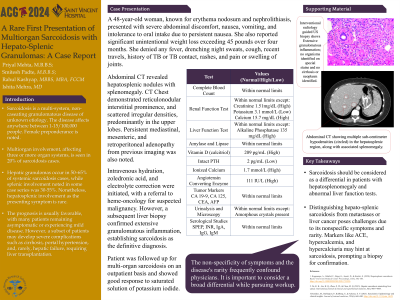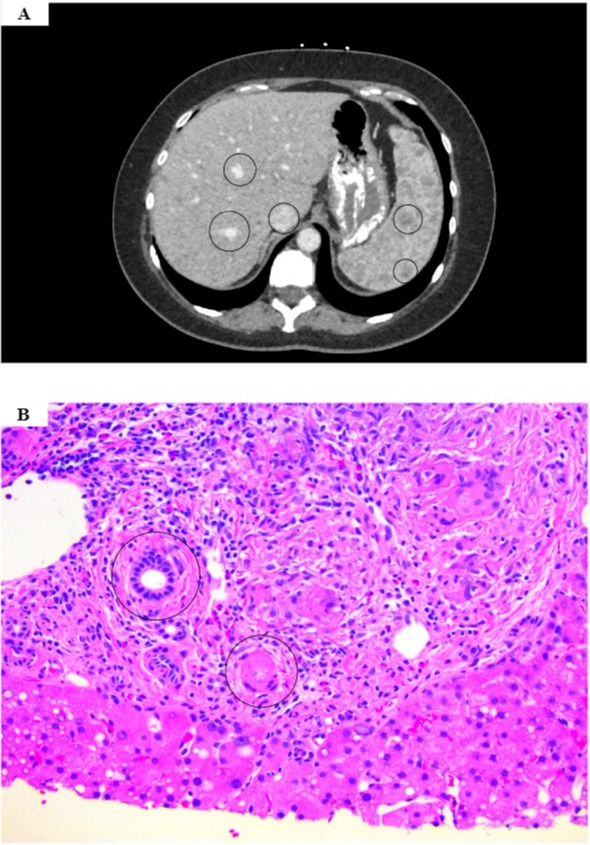Monday Poster Session
Category: Liver
P3102 - A Rare First Presentation of Multiorgan Sarcoidosis With Hepato-Splenic Granulomas: A Case Report
Monday, October 28, 2024
10:30 AM - 4:00 PM ET
Location: Exhibit Hall E

Has Audio
- PM
Priyal D. Mehta, MBBS
Saint Vincent Hospital
Worcester, MA
Presenting Author(s)
Priyal D. Mehta, MBBS1, Smitesh Padte, MBBS2, Rahul Kashyap, MBBS, MBA2, Ishita Mehra, MD3
1Saint Vincent Hospital, Worcester, MA; 2WellSpan Health Hospital, York, PA; 3St. Michael Medical Center, Silverdale, WA
Introduction: Sarcoidosis is a non-caseating granulomatous disease of unknown etiology that can affect practically any organ system. African Americans exhibit a prevalence rate of 17.8/100,000, contrasting with 8.1 for Whites and 4.3 for Hispanics. This polarity could be due to genetic factors influencing both the susceptibility and the manifestation of distinct clinical phenotypes. Similarly, while 90% of cases involve the pulmonary system, only 10% are extra-pulmonary. We present a rare case of hepato-splenic sarcoidosis without pulmonary involvement that mimicked liver cancer.
Case Description/Methods: A 48-year-old woman, known for erythema nodosum and nephrolithiasis, presented with severe abdominal discomfort, nausea, vomiting, and intolerance to oral intake due to persistent nausea. She also reported significant unintentional weight loss exceeding 45 pounds over four months. Laboratory analysis upon admission unveiled profound hypercalcemia (15.7 mg/dl), acute kidney injury (creatinine=1.51 mg/dl), and hypokalemia (3.1 mg/dl). Abdominal CT revealed hepatosplenic nodules with splenomegaly, reticulonodular interstitial prominence, and scattered irregular densities, predominantly in the upper lobes. Persistent mediastinal, mesenteric, and retroperitoneal adenopathy with little difference from previous imaging was also noted. Other noteworthy findings included elevated 1,25-dihydroxyvitamin D, heightened ACE levels (111 IU/L), and suppressed intact parathyroid hormone. Intravenous hydration, zoledronic acid, and electrolyte correction were initiated, with a referral to heme-oncology for suspected malignancy. However, a subsequent liver biopsy confirmed extensive granulomatous inflammation, establishing sarcoidosis as the definitive diagnosis. The treatment, along with continued outpatient follow up, has resulted in improvement of her symptoms.
Discussion: Hepatic granulomas occur in 50–65% of systemic sarcoidosis cases, but isolated hepatosplenic involvement is rare. It should be considered in patients with hepatosplenomegaly and abnormal liver function tests. Markers like ACE, hypercalcemia, and hypercalciuria may suggest sarcoidosis but are not diagnostically sufficient. In such cases, a biopsy can diagnose and differentiate it from metastases or liver cancer. However, this can be challenging due to it's nonspecific symptoms and rarity. This can frequently confound physicians, making this an important case that underscores the consideration of a broad differential while pursuing work-up.

Note: The table for this abstract can be viewed in the ePoster Gallery section of the ACG 2024 ePoster Site or in The American Journal of Gastroenterology's abstract supplement issue, both of which will be available starting October 27, 2024.
Disclosures:
Priyal D. Mehta, MBBS1, Smitesh Padte, MBBS2, Rahul Kashyap, MBBS, MBA2, Ishita Mehra, MD3. P3102 - A Rare First Presentation of Multiorgan Sarcoidosis With Hepato-Splenic Granulomas: A Case Report, ACG 2024 Annual Scientific Meeting Abstracts. Philadelphia, PA: American College of Gastroenterology.
1Saint Vincent Hospital, Worcester, MA; 2WellSpan Health Hospital, York, PA; 3St. Michael Medical Center, Silverdale, WA
Introduction: Sarcoidosis is a non-caseating granulomatous disease of unknown etiology that can affect practically any organ system. African Americans exhibit a prevalence rate of 17.8/100,000, contrasting with 8.1 for Whites and 4.3 for Hispanics. This polarity could be due to genetic factors influencing both the susceptibility and the manifestation of distinct clinical phenotypes. Similarly, while 90% of cases involve the pulmonary system, only 10% are extra-pulmonary. We present a rare case of hepato-splenic sarcoidosis without pulmonary involvement that mimicked liver cancer.
Case Description/Methods: A 48-year-old woman, known for erythema nodosum and nephrolithiasis, presented with severe abdominal discomfort, nausea, vomiting, and intolerance to oral intake due to persistent nausea. She also reported significant unintentional weight loss exceeding 45 pounds over four months. Laboratory analysis upon admission unveiled profound hypercalcemia (15.7 mg/dl), acute kidney injury (creatinine=1.51 mg/dl), and hypokalemia (3.1 mg/dl). Abdominal CT revealed hepatosplenic nodules with splenomegaly, reticulonodular interstitial prominence, and scattered irregular densities, predominantly in the upper lobes. Persistent mediastinal, mesenteric, and retroperitoneal adenopathy with little difference from previous imaging was also noted. Other noteworthy findings included elevated 1,25-dihydroxyvitamin D, heightened ACE levels (111 IU/L), and suppressed intact parathyroid hormone. Intravenous hydration, zoledronic acid, and electrolyte correction were initiated, with a referral to heme-oncology for suspected malignancy. However, a subsequent liver biopsy confirmed extensive granulomatous inflammation, establishing sarcoidosis as the definitive diagnosis. The treatment, along with continued outpatient follow up, has resulted in improvement of her symptoms.
Discussion: Hepatic granulomas occur in 50–65% of systemic sarcoidosis cases, but isolated hepatosplenic involvement is rare. It should be considered in patients with hepatosplenomegaly and abnormal liver function tests. Markers like ACE, hypercalcemia, and hypercalciuria may suggest sarcoidosis but are not diagnostically sufficient. In such cases, a biopsy can diagnose and differentiate it from metastases or liver cancer. However, this can be challenging due to it's nonspecific symptoms and rarity. This can frequently confound physicians, making this an important case that underscores the consideration of a broad differential while pursuing work-up.

Figure: The image shows the diagnostic work-up done for the patient. Figure A - Abdominal CT scan shows multiple sub-centimeter hypodensities (circled) in the hepatosplenic region, associated with splenomegaly. Figure B - Interventional radiology-guided ultrasound biopsy of the liver showed extensive granulomatous inflammation (circled); no organisms were identified on special stains (AFB, GMS, PAS/D); and no cirrhosis or neoplasm was identified.
Note: The table for this abstract can be viewed in the ePoster Gallery section of the ACG 2024 ePoster Site or in The American Journal of Gastroenterology's abstract supplement issue, both of which will be available starting October 27, 2024.
Disclosures:
Priyal Mehta indicated no relevant financial relationships.
Smitesh Padte indicated no relevant financial relationships.
Rahul Kashyap indicated no relevant financial relationships.
Ishita Mehra indicated no relevant financial relationships.
Priyal D. Mehta, MBBS1, Smitesh Padte, MBBS2, Rahul Kashyap, MBBS, MBA2, Ishita Mehra, MD3. P3102 - A Rare First Presentation of Multiorgan Sarcoidosis With Hepato-Splenic Granulomas: A Case Report, ACG 2024 Annual Scientific Meeting Abstracts. Philadelphia, PA: American College of Gastroenterology.
